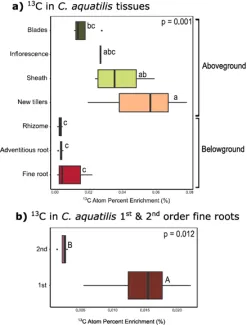Aboveground, this sedge species transfers recently fixed carbon from blades to newly developing tillers, whereas belowground, fixed carbon is preferentially allocated to terminal fine root tips.
The effect of temperature on above- versus belowground carbon dynamics is largely unknown in rapidly warming arctic ecosystems, despite their crucial role providing water and nutrients to plants. The team tested whether one growing season of warming would affect carbon allocation of an aerenchymous sedge, Carex aquatilis. In 2021, we conducted a field campaign in Utqiaġvik, Alaska, in which the team sampled warming chambers that elevated air temperatures by 3–4℃. During peak growing season, photosynthate of C. aquatilis was isotopically labeled by exposing plots to 13C-CO2 for one hour at midday. Five days after the isotopic labeling event, above- and belowground biomass of C. aquatilis was harvested. The samples processed thus far provide insufficient statistical power to test for the effect of warming treatment on carbon allocation but do reveal interesting patterns across plant tissues. Overall, tissue type was a significant predictor of 13C enrichment (Figure 6a; p = 0.001), and aboveground tissues tend to be more enriched in 13C than belowground tissues (p < 0.001). Aboveground, 13C was transferred from blades to sheaths and then onto newly developing tiller buds. Belowground, 13C was preferentially allocated to fine roots rather than to rhizomes or adventitious roots. Specifically, the team observed that first-order (terminal) fine roots had higher 13C enrichment than the second order roots from which they branched (Figure 6b; p=0.012). The elevated 13C in first-order fine roots and new tiller buds indicates that recently fixed carbon is allocated toward tissue experiencing rapid growth and turnover. In the coming months, the team will continue processing samples from this experiment to assess whether warming modified this allocation pattern.
For more information, please contact:
Verity Salmon
salmonvg@ornl.gov

